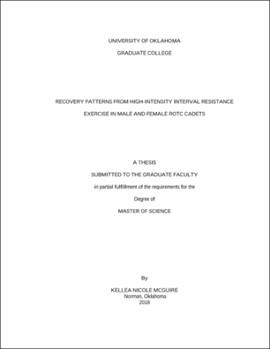| dc.description.abstract | Background: Army Reserve Officers’ Training Corps (ROTC) must meet military expectations mentally and physically. Training for ROTC cadets cadres around improving 2-mile run time, push-ups and sit ups which is primarily endurance focused. It is important for ROTC to incorporate resistance training into their normal training routine to improve military tasks and load carriage. Little evidence is presented in past literature covering the effect of high-intensity resistance exercise on ROTC cadets. Primary Aim: The primary aims of this study are 1) To determine the time-course for recovery in Army ROTC cadets following a bout of high-intensity interval resistance exercise, 2) To examine if there are any sex differences for recovery following high-intensity interval resistance exercise, and 3) To validate the use of CMJ as a measure of fatigue following a bout of high-intensity interval resistance exercise. Methods: 19 subjects, 10 male and 9 female ROTC cadets performed a bout of high-intensity interval resistance exercise using their 10RM load. The exercise consisted of a 3 circuit exercise using 8 exercise machines. Subjects provided soreness ratings and perceived recovery status (PRS) prior to performing upper and lower body counter-movement jumps (CMJ). Following CMJs, subjects performed the high-intensity resistance exercise by doing 3 rounds of the 8 exercises with 60 seconds of work at their 10RM and 60 seconds of rest between exercise machines. Subjects gave RPE after each round and once the exercise was complete, subjects performed another 5 upper and lower body CMJs. Thirty-minutes post exercise, subjects provided session RPE (sRPE) to rate the exercise as a whole. Subjects performed this protocol 4 different times; at baseline and 24, 48 and 72 hours post baseline. The last three experimental times were randomized and counterbalanced. Results: Exercise performance recovery was determined by the total repetitions performed for each of the 4 experimental trials. Male and female subjects did not differ in exercise performance recovery for all time points. Baseline performance was the lowest compared with 24H, 48H and 72H while 24H, 48H and 72H were not different from each other. CMJ performance was not significantly different from pre-to-post exercise for 24H, 48H and 72H. Baseline CMJ performance decreased from pre-to-post. Males had greater CMJ variables compared with women. Soreness ratings showed that 24H had the greatest soreness compared with baseline and 72H. Upper body soreness ratings were higher compared with lower body soreness for baseline, 24H and 48H. Males and females did not differ in soreness ratings. PRS was significantly lower at 24H compared with baseline and 72H. PRS was also highly correlated with soreness ratings for all time points. sRPE did not differ between time points or male and female subjects. RPE following each round of the exercise showed that set 1 had the lowest RPE compared with set 2 and 3 for all time points and set 2 was lower than set 3 for 24H and 72H. Males and females did not differ in RPE for all sets. Conclusion: ROTC cadets were able to recover 24H following a bout of high-intensity interval resistance exercise with no difference seen between male and female cadets. CMJ did not decrease from pre-to-post exercise and did not match the change in exercise performance as hypothesized. Soreness ratings were greatest at 24H indicating both male and female cadets were most sore 24H following a bout of high-intensity interval resistance exercise. PRS matched the pattern of soreness ratings which indicates that PRS is mainly associated with soreness and not exercise performance recovery. sRPE was unchanged between time points meaning subjects perceived similar exertion between time points. Overall, more investigating needs to be conducted to analyze recovery patterns following a bout of high-intensity interval resistance exercise in ROTC cadets while incorporating CMJs to validate the use of CMJ as a surrogate to measure performance. However, this resistance exercise could be a good initial exercise to improve performance in ROTC cadets. Keywords: resistance exercise, recovery, fatigue, ROTC cadets | en_US |
